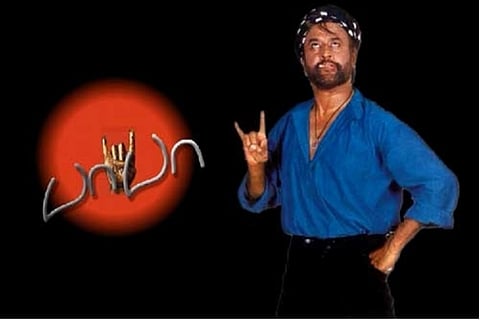

After years of speculation on when he will join politics if at all, Rajinikanth made the big announcement on the last day of 2017. As several people joked on social media, everyone else was looking for a New Year party to go to, while Rajinikanth simply created his own.
Rajini claimed in his speech that he made the decision not because he was power hungry but because of the political situation in Tamil Nadu which had left its people "hanging their heads in shame."
However, it is a fact that the actor has nursed political ambitions for a long time now but had remained uncertain about when to take the plunge. The memory of actor Sivaji's unimpressive political run, despite being a huge star in the state, was a sobering lesson to many from the film world who had looked upon cinema as an easy springboard to politics.
Rajini's chosen symbol, known in popular culture as the "Baba symbol", has led to much theorising on what it could stand for. The hand position is called Apana Mudra in yoga and stands for "detoxification and purification". It also finds resonance in other traditions and cultures and has similar meanings and implications.
The 2002 film Baba was about a young man, an atheist who is given to the vices, discovering spirituality and "detoxifying" himself to realise the truth about the world. The film was produced by Rajini under the banner LOTUS International – while it's tempting to say that this had to do with Rajini's widely perceived sympathy for the BJP, the lotus flower is of symbolic significance in Hinduism.
In the Bhagavad Gita, for example, a human being is expected to function like a lotus, untouched by sin like a drop of water on the lotus leaf, and rising above the slush. Further, the ashram of Satchidananda Swami, Rajini's spiritual guru on whom Baba was based, has a temple called Light of Truth Universal Shrine (LOTUS) and Rajini's production company was supposedly named after this temple.
Although Baba was a flop at the time of its release, it takes on special significance as Rajini is all set to launch his political party. The film was very close to the actor's heart, and he was dejected when the audience rejected it. Rajini took a break after the Baba debacle and came back to the screen with a bang – this time, with Chandramukhi, the Tamil remake of a Malayalam psychological thriller.
Ironically, he played a rational psychiatrist in Chandramukhi, a man who pooh-poohs superstitions and comes up with a scientific explanation for so-called supernatural phenomena.
Directed by Suresh Krishna, Baba was the closest Rajini came to experimentation after he attained his superstardom. Baba, the film's protagonist played by Rajinikanth, is the reincarnation of a saint from the Himalayas. Interestingly, the symbol launched by the actor on the 31st includes a snake (the circle around the mudra is actually a snake) which stands for the cycle of life, death and rebirth in Hinduism.
Though Baba dismisses religion as mumbo-jumbo initially, he becomes a believer in destiny and god once he meets the 2000 year old saint after whom he was named. In the film, Baba acts as a kingmaker, ensuring the victory of an honest man as the Chief Minister of the state. Pertinently, he does this through a boon that he could have used for himself. Despite his followers asking him to become the "permanent CM", Baba rejects the allure of political power and chooses instead to renounce the world and ascend the Himalayas.
But the film doesn't end at that point – the good CM is shot dead even as Baba is walking away with the sages. As he hears the shots, Baba turns back and walks towards the people with determination. The sage, dressed in saffron, bless him, gets a weapon in his hand to signify that he's ready to fight the good fight and a piece of cloth comes flying in the air and coils around his head like a snake to form a turban. And yes, Baba holds his other hand in the yogic mudra that has now become the actor's political symbol.
Interestingly, the 2002 film ends with 'To be continued' – was that to say a sequel was on the way, or a cinematic announcement about Rajini's entry into politics? More than a decade ago, Rajini fans were flummoxed by the film and what the actor wanted to say through it. It did so badly that Rajini had to compensate distributors and theatre owners.
Fifteen years later, the film lends itself to a more informed reading. Just as in Baba, Rajini has positioned himself as entering the political arena not for power, but because the people "need" him. In his speech, the actor asserted that he had been compelled to join politics because he was disgruntled with how the state was being run. The actor reminded his fans that if he so wished, he could have grabbed power at 45 years of age and that he had chosen to wait thus far only because his real intentions were not political power, but something loftier.
Rajini has kept his political ideology under the broad heads of 'anti-corruption' and 'transparency', much like his contemporary from the cinema industry Kamal Haasan, who is also looking to enter politics. However, those who have watched Rajinikanth's political moves closely suspect that his desire to infuse politics with 'spirituality', translates to aligning with Hindutva forces to saffronise the state.
Rajini's party is yet to take off. For all his talk on spirituality and higher goals, will his political avatar be a hit or a flop like Baba? In a state that has been ruled by two Dravidian parties which have their origins in the rationalist movement? Only time can tell.